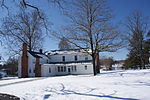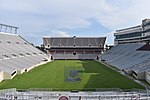Virginia Tech
Virginia Tech (VT), formally the Virginia Polytechnic Institute and State University (VPI), is a public land-grant research university with its main campus in Blacksburg, Virginia. It also has educational facilities in six regions statewide, a research center in Punta Cana, Dominican Republic, and a study-abroad site in Riva San Vitale, Switzerland. Through its Corps of Cadets ROTC program, Virginia Tech is a senior military college.Virginia Tech offers 280 undergraduate and graduate degree programs to its 37,000 students; as of 2016, it was the state's second-largest public university by enrollment. It is classified among "R1: Doctoral Universities – Very high research activity".The university's athletic teams are known as the Virginia Tech Hokies and compete in Division I of the NCAA as members of the Atlantic Coast Conference. VT alumni include 2 Rhodes Scholars, 4 Marshall Scholars, 38 Goldwater Scholars, and 131 Fulbright Scholars. Among its alumni are 8 Medal of Honor recipients, 97 flag officers, governors of two U.S. states, 2 astronauts, and a billionaire. Three Nobel laureates and two MacArthur Fellows have received a degree or served as faculty members at the university. As of 2015, VT had more than 240,000 living alumni worldwide.
Excerpt from the Wikipedia article Virginia Tech (License: CC BY-SA 3.0, Authors).Virginia Tech
Drillfield Drive, Blacksburg
Geographical coordinates (GPS) Address External links Nearby Places Show on map
Geographical coordinates (GPS)
| Latitude | Longitude |
|---|---|
| N 37.225 ° | E -80.425 ° |
Address
Virginia Polytechnic Institute and State University (Virginia Tech)
Drillfield Drive 800
24061 Blacksburg
Virginia, United States
Open on Google Maps







